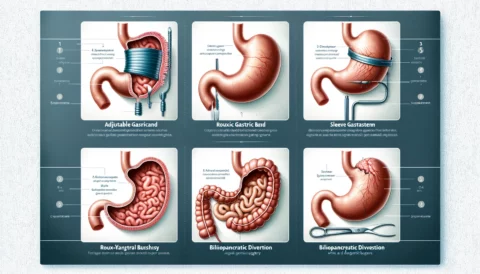Gastric bypass surgery is widely recognized in the world of bariatric procedures for its effectiveness and transformational outcomes. The roots of this surgery are deep-seated in the medical annals, tracing back to several decades. This article aims to walk you through the timeline of gastric bypass, detailing its origins, advancements, and the modern approach in a city like Dallas, Texas, that has become a hub for such procedures.

The Beginning: Inspiration from Mother Nature
The very idea of bypassing part of the digestive tract for weight loss wasn’t a human invention. In fact, nature showcased this possibility in animals suffering from certain congenital anomalies, where food bypassed the stomach due to anatomical variations. This phenomenon demonstrated a key observation: those animals displayed noticeable weight loss.
Historians of medical science often hint at the possibility that observing such natural occurrences might have sown the seed of what we now recognize as the gastric bypass procedure.
Early Attempts: Pioneering Steps in Bariatric Procedures
In the initial stages, surgery for obesity wasn’t focused on bypassing the stomach. However, it was evident that the medical community recognized the growing concern of obesity and its impacts. The need for surgical intervention was evident, but the best method was still in deliberation. In those times, other procedures like jejunoileal bypass gained popularity. This procedure connected the upper part of the small intestine to the lower part, bypassing a significant portion. While it led to weight loss, complications arose due to bypassing such a large section of the digestive tract.
It was during these experimental phases that surgeons realized the potential of bypassing only a small portion of the stomach to achieve weight loss, with fewer complications.
The Rise of Gastric Bypass
By the 1960s, the concept of gastric bypass started to gain traction. A more refined procedure was established where a small pouch of the stomach was created and then connected directly to the small intestine. This led to the birth of what we now understand as the modern Roux-en-Y gastric bypass.
Dallas, with its state-of-the-art medical facilities, played a pivotal role in refining and advancing these procedures. The city, already a burgeoning medical hub, provided an ideal backdrop for the evolution of bariatric surgeries, making it one of the premier destinations for patients seeking top-notch care.
Bridging Myths and Facts
Over the years, as with many groundbreaking medical procedures, gastric bypass became subject to various myths and misconceptions. Misinformation spread regarding its risks, benefits, and recovery. Recognizing the need for clear communication, experts from facilities like Peak Bariatric took initiatives to debunk these myths and provide patients with factual information.
Gastric Bypass Today: The Modern-Day Procedure
Today, with advancements in medical science and technology, the gastric bypass procedure is more efficient than ever. Surgeons in Dallas provide a step-by-step walkthrough of the entire process, ensuring patients are well-informed and comfortable. Additionally, there is a growing focus on the holistic treatment of patients, emphasizing both physical and emotional aspects.
“The journey of a thousand miles begins with one step.” – Lao Tzu
Such is the journey of gastric bypass. What started as observations in nature, followed by years of experimentation and refinement, has evolved into a life-changing procedure that continues to transform lives in Dallas and beyond.
The Evolution of Gastric Bypass: Modern Era
The Emergence of Modern Techniques
Gastric bypass, a name synonymous with weight loss surgeries, has evolved leaps and bounds over the past few decades. The 20th century witnessed remarkable advancements in this surgery type, particularly in the ’60s and ’70s. The procedure’s transformation from its rudimentary form to its contemporary manifestation is a testament to medical science’s progress and dedication.
The introduction of laparoscopic techniques marked a significant milestone in the history of gastric bypass. Laparoscopy offered a less invasive alternative to the open surgical method, with smaller incisions, reduced post-op pain, and quicker recovery. This minimally invasive procedure gained immense popularity, and by the late 20th century, it had almost entirely replaced the open surgical method.
Debunking the Myths
With the rise in popularity of the gastric bypass, several myths and misconceptions began to emerge. Contrary to popular belief, gastric bypass is not an “easy way out” or a magical solution to obesity. It requires patients to commit to long-term weight maintenance and adopt a healthy lifestyle. Addressing these myths became crucial for medical practitioners to ensure patients had realistic expectations and understanding of the procedure.
Gastric Bypass in Dallas: A Thriving Scene
Dallas, Texas, quickly emerged as a significant hub for bariatric surgery. The city became home to numerous state-of-the-art clinics offering gastric bypass procedures, with expert surgeons leading the way. Choosing the right surgeon became paramount for individuals considering the surgery, as expertise, experience, and patient care started differentiating the good from the best.
One vital aspect of the procedure that patients often overlook is the post-surgical phase. The importance of preparing for a successful recovery cannot be stressed enough. The recovery journey includes following strict nutritional guidelines, joining support groups, and being aware of potential challenges, such as overcoming common post-operative issues.
Expanding Options and Considerations
While gastric bypass grew as the preferred choice for many, there was also a noticeable increase in interest around non-surgical alternatives. With the advancements in medical science, patients now had a buffet of options to choose from. But, understanding the pros and cons of each was vital. From the traditional gastric bypass to lap-band surgery and sleeve gastrectomy, the choices are aplenty, but one size doesn’t fit all. Each procedure comes with its own set of advantages, risks, and recovery patterns.
Gastric Bypass and Society: Transforming Lives Beyond Weight Loss
The Societal Ripple Effect
The prominence of gastric bypass isn’t just limited to the medical community. Its impact reverberates in society at large. For many individuals in Dallas and beyond, this procedure is more than just about shedding pounds; it’s a journey of reclaiming one’s life, health, and confidence.
Gastric bypass’s societal influence is profound. Its success stories have been pivotal in dispelling the stigma around obesity, driving home the point that obesity is a complex health concern and not just a matter of willpower.
Personal Triumphs: Beyond the Scale
Many inspiring stories emerge from Dallas’s clinics, where individuals narrate their battles with obesity, comorbidities, and societal judgment. The triumphs aren’t always measured in pounds lost but also in the new-found joy of living an active life, mitigation of health risks, improved mental well-being, and a surge in self-esteem.
In the heart of Dallas, community groups and support meetings are commonplace, offering a safe space for pre and post-op patients to share experiences, offer guidance, and uplift each other.
A Glimpse Into the Future: Innovations and Beyond
The realm of gastric bypass surgery is dynamic and ever-evolving. With technological advancements, the horizon looks promising. Dallas, being at the forefront of medical innovation, is already witnessing the next wave of procedures. Robotics and AI-driven techniques are paving the way for even more precision, reduced recovery times, and better patient outcomes.
Moreover, there’s an increasing emphasis on holistic care. The understanding is clear: gastric bypass isn’t just a surgical intervention. The future might see more integrated approaches, combining surgery with mental health support, nutritional guidance, and tailored fitness regimens.
Conclusion
Gastric bypass, especially in vibrant communities like Dallas, has come a long way from its initial days. It’s not just a medical procedure but a societal movement, empowering countless individuals to embark on a healthier, happier life journey. As the chapters of its history unfold, one thing remains constant: the relentless pursuit of betterment, both in medical expertise and in the holistic betterment of patients’ lives.
Key Takeways
- The Societal Ripple Effect
- Gastric bypass has a significant impact on society, beyond the medical realm.
- Helps in dispelling the stigma around obesity by showcasing it as a complex health concern.
- Personal Triumphs: Beyond the Scale
- Success stories from Dallas highlight more than just weight loss.
- Benefits include an active lifestyle, reduced health risks, enhanced mental well-being, and boosted self-confidence.
- Dallas hosts community groups and support meetings for pre and post-op patients.
- A Glimpse Into the Future: Innovations and Beyond
- Technological advancements promise a brighter future for gastric bypass procedures.
- Dallas is leading with robotics and AI-driven techniques.
- The emphasis is increasing on holistic care: combining surgery with mental health support, nutritional guidance, and fitness regimens.
- Conclusion
- Gastric bypass is not just a medical procedure but a societal movement.
- Focuses on bettering medical techniques and improving patients’ holistic well-being.






